If you have a website, blog, or eCommerce store, then chances are that you already have heard about SEO and the importance of SEO.
But what the heck does SEO mean? You’ve got that itchy question in your mind, right?
Don’t worry; I’ll answer your question.
Although it sounds like rocket science when we first hear about it but trust me, it’s not.
We have to perform the basic SEO and the rest follow-up.
So in this blog post, you’ll learn What SEO is, how it works, and the best SEO practices for your website.
This SEO guide will apply to all content management systems because all follow the same SEO process.
And yeah, read this entire blog post: “Half knowledge is dangerous”.
So without further due, let’s dive right in.
What is SEO, and how does it work?
Let me give you a technical definition – SEO stands for search engine optimization, and doing SEO can bring Lots of organic search traffic to our website.
This explanation doesn’t explain much about what is right.
Let me explain it further.
SEO is the process of making our websites (Blog posts, web page, product page) optimized for Search engines so that our website gets ranked on the first page first position for a targeted keyword that visitors type in the search engines and for getting lots of search engine traffic.

Now you may ask what the need for optimizing our web assets for search engines is.
The answer is simple we want to rank our websites at the top of Search engines for our targeted keyword.
And the reason why we want to have that 1st position on SERP is that as your SERP position decreases, then traffic also decreases.
The maximum search traffic goes to the top-ranking website, and more traffic means more eyeballs and, ultimately, more money.
SEO came into existence because everyone wants to rank their website in search engines to get the most amount of traffic to their websites.
That’s why everyone started implementing SEO.
And that’s the reason why everyone wants to learn SEO and make their websites rank on search engines.
This is the reason SEO is getting harder and harder every day, but this doesn’t mean that SEO can’t be done.
SEO can be done, but it depends on your niche’s competitiveness and hard work.
There are lots of untapped niches with meager competition, and in intense competition, niches ranking a website is easy and hence can get a lot of traffic quickly.
But no matter how stiff the competition is, we can be at other competitors’ levels or higher with the right strategies and consistency.
Signs of competition are always a good sign; signs of the competition show that there is money to be made that’s why people are going for that niche.
But it’s not a good decision to choose a niche because of competition or by seeing the traffic potential.
You have to choose your niche based on your (passion + profitability + knowledge) in that niche.
Also read: How to Find a Profitable Niche For Your Blog (Proven Method)
So let’s get back to our main topic…
We need to optimize our website for search engines because if we do not optimize our content for search engines, then bots or crawlers will find it challenging to figure out what your content is about and what to rank it for.
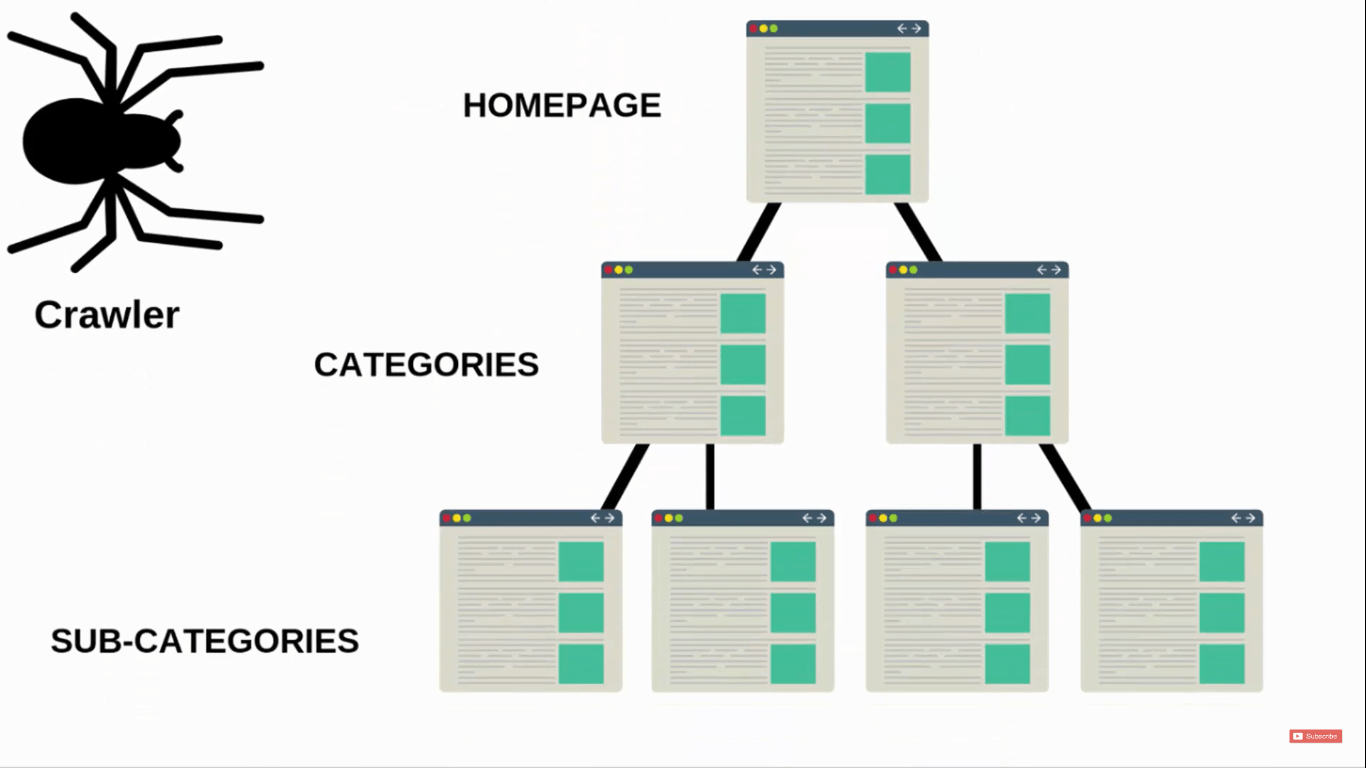
You might have got an idea of how search engine bots crawl your website from the above image.
They crawl your whole website and analyze everything, including content, keywords, backlinks, and other metrics, and after that, they index your website.
And based on that search engine’s algorithms, the search engine shows desired search results to the searcher.
So that is why you have to make everything clear for search engines with the help of SEO so that they can understand what your content is all about and for what query to rank your content.
And if your web page is not correctly optimized for keywords and SEO, then search engines will find it difficult to index your content on the search engines, and search engines will have a hard time determining what your content is about.
And if your Content doesn’t get indexed, your content will never rank in search engines, and all your hard work will be wasted.
And you will never get targeted traffic, sales, and conversion for your website from search engines unless you have an alternative traffic source from social media.
So any Website owner must do proper SEO (Search engine optimization).
We do SEO for specific keywords,
For example, if there’s a keyword “How to do x in 20 minutes” that you want your content to rank in search engines.
So you will have to do proper SEO for that keyword to make search engines think that your webpage has the most valuable content.
Now search engines can be of any type.
Search engines can be any platform where people search for something using keywords.
- Google: all in one biggest Search engine
- Pinterest & Instagram: image search engine
- Yelp: local business search engine
- TripAdvisor: travel search engine
- iTunes: podcast & music search engine
- Amazon: product shopping search engine
- YouTube: video search engine, second largest search engine after google
So these are some of the search engines where people perform SEO to get their web assets more visibility and conversions.
That, in a nutshell, is what SEO is all about.
Types of SEO
- On page SEO
- OFF page SEO
- Technical SEO
Let’s look at all 3 of them one by one.
What is On-page SEO?
On-page SEO refers to the optimization or changes we make within our website and content to make our website more visible to search engines is called ON page SEO.
I like to call it making our content relevant.
On-page SEO begins with keyword research.
And making our content relevant means at least having our target keyword or related keywords in the title, description, and other prominent places of the content.
On-page SEO includes practices like keyword research, putting those researched keywords in prominent places of your blog posts also known as keyword prominence.
These are some of the prominent places to put your main target keyword.
- Keywords in URL
- Keywords in the meta title
- Keywords in the meta description
- Keywords in the first 100 words of content
- Keywords in the last 100 words of content
- Keywords inside the body of your Content
- Keywords in the blog post title
- Keyword in the image alt text
So these are some prominent places where our main keyword needs to be to tell the search engines what your blog post or webpage is all about.
Also Read: Where to place Keywords in your blog post content to maximize traffic from search engines.
And also, let’s not forget the LSI keywords, which play a massive role in making our content relevant to other similar keywords.
Also, don’t forget to include LSI keywords in your content.
It will boost your search rankings.
How to do On-page SEO in WordPress?
On-page SEO on WordPress websites is relatively easy compared to custom hardcoded websites.
We only need a plugin to make our website’s On-page SEO optimized.
While there are lots and lots of plugins like Yoast, all-in-one SEO plug-ins, etc.
There’s one plugin that’s my personal favorite.
And that plugin is the Rankmath SEO plug-in.
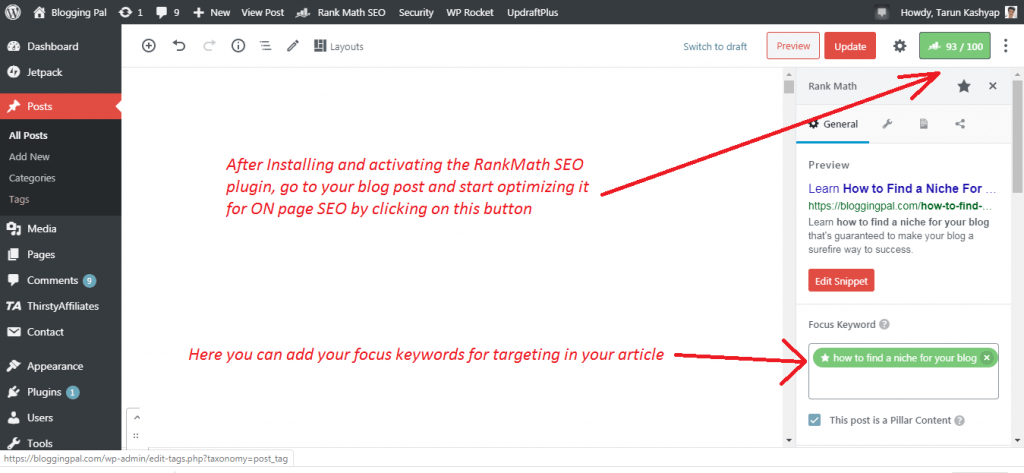
RankMath SEO has its own set of parameters that will help you to give your content the right direction and to write an excellent On-page SEO-optimized article.
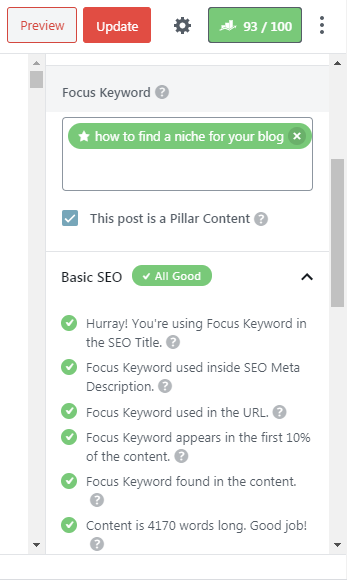
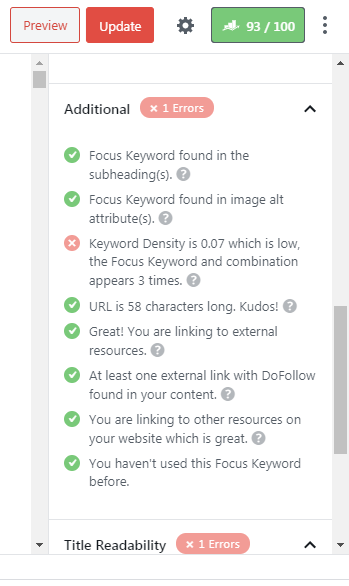
I like to use this plugin is that this plugin offers all the features for FREE that other plugins are not willing to provide for FREE.
Before the Rankmath SEO plug-in, the Yoast SEO plug-in dominated the SEO plug-in market, but after the excellent FREE Rankmath SEO plug-in, everything completely changed.
RankMath SEO Plugin provides all the paid features from the Yoast SEO plug-in for free.
- Interlinking related content
- Adding more than 1 focus keyword
- Redirections
- 404 monitors.
- Site SEO score and much more for free
But this multipurpose SEO plug-in’s primary purpose is to optimize our website’s On-page SEO, and it does that job very well.
So if you haven’t already installed the Rankmath SEO plug-in on your website, consider installing it immediately.
When it comes to On-page SEO, people think it’s just about keywords and not the content.
And this can lead to a big problem as Google is very strict towards keyword stuffing and not providing the actual real value to the reader.
You have to put Keywords wherever it makes sense, not just forcing the keywords, and it will be something of enormous value to the reader.
Your reader’s query must solve after reading your blog post; that should be your goal.
So overall, On-page SEO is for telling search engines that the content of your website is related to a specific keyword and its associated keywords.
That’s what On-page SEO is about, making your content related to your keywords so that search engines can find your content when your target keyword is typed in search engines.
What is OFF page SEO?
Ok, now that you have your website’s content in place and published excellent articles on your blog.
Now you might be thinking that you will start getting traffic, and your article or webpage will rank immediately on search engines as soon as you publish, right?
Well, it’s wrong.
How will Google know that your content is worth ranking for your target keyword?
Because there are other people also publishing Content on the same topic.
So how did Google decide whose Content to rank first and which not to rank?
That’s where OFF page SEO comes into the picture.
Off-page SEO means all the activities that you do outside of your website to make it look good to the search engines for a relevant query is called OFF page SEO.
After you have done everything, i.e, written your blog post and optimized it for on-page SEO, it’s time to tell Google that your content is worthy of ranking at the top.
And To do that, you will need to send external signals to your website from external resources.
There are lots of OFF page factors that help in off-page SEO.
But let me tell you about the critical OFF Page SEO Metrics.
- Backlinks (Dofollow & Nofollow)
- Social signals
- No engagements on your blog post
- User behavior on your website.
So these things help your content to appear more valuable to Search engines.
Let’s talk about Backlinks; they are considered one of the top 3 ranking factors by many SEO experts worldwide.
Essentially Backlinks are considered as votes, and Google also does consider them as votes.
The more backlinks you have than your competitors means you have more votes for your content than your competitor’s content.
And this makes search engines think that your content is worthy of being ranked at the top because many other people are linking to your content.
This is why gaining backlinks for your piece of content is very crucial.
Although sometimes some pages Rank without having backlinks on top of pages that have backlinks, it’s just about how Google Sees it.
According to a recent study by Mr. Brian Dian from Backlinko, There are over 200+ ranking factors that Google considers while ranking a webpage.
And backlinks are one of them, and backlinks are also one of Google’s top 3 ranking factors.
So you should always consider creating backlinks for your website after you publish your Content on your website.
There are many ways you can make backlinks for your blog posts.
The most efficient ways of creating backlinks are
- Guest posting on related niche sites
- Blog commenting on High authority sites in your niche
- Broken link building
- Deep broken link building
- Forums and directory submission
- Try to create Wikipedia backlinks
- Earn .gov & .edu backlinks through broken link building
- Use HARO services
- Create your profile on different profile creation sites and add your website’s link.
- Answer questions on Quora
- Use Scoopit
- Contribute to the Reddit community
- Create engagement on communities like Facebook groups
- Submit your website to local business directories if you’re a local business
- Earn backlinks through infographics
- Leverage Blogger Outreach
And the next important OFF page SEO factor is social signals.
If you give good social signals to your blog post and some backlink signals soon after it’s published and you keep giving these signals consistently for a few days, then your blog post has a high chance of getting higher SERP rankings fast.
Another critical factor is how the user behaves on your website after he lands on your website.
Search engines also consider some key points.
- What is the bounce rate (User Signals)
- Is your site using SEO friendly theme?
- How friendly is your site for users and crawlers
- What’s the load time of your website
- How much time a user spends on each post (Dwell Time)
- How many pages does the user visit inside your website
- Also, how many engagements and comments do your blog posts get?
These all above factors are called social signals; if Google See’s that the social signals on your website are not good, then your Content will never rank.
So these are the critical off-page factors that tell Google about the quality of your website.
So overall your website has to be perfect in these below-mentioned aspects.
- The Structure should be Great
- Provide great user experience
- Reduce the load time of your website
- Make your website look and feel amazing
- Add crispy great-looking images
Because there are over 200+ ranking factors, you never know why your website may get penalized the other day.
Trust me, SEO is utterly whole Lot more than what I discussed in this article, but this article was to give you an overview of what SEO looks like.
SEO is a deep topic, and as you learn more about it, you will realize that it’s a never-ending process as Google also breaks out algorithm updates every other day.
SEO is a forever ongoing process.
But as I said, in the beginning, you don’t need to overcomplicate things; you need to get the basic stuff done, and you’re all good.
So it’s essential to keep everything simple and transparent and give what users want. That’s what modern-day SEO looks like.
What is Technical SEO?
Technical SEO refers to all the technical aspects of our website, and ensuring that all the technical things of our website are working fine is called technical SEO.
Technical SEO includes.
- Making sure our website is loading fast
- Making sure our website is User-friendly
- Making sure the website is optimized for both users and search engines.
- Ensure all the essential elements are in place, like social sharing buttons, footer, analytics code, menu place all pages navigation is good.
- All these things fall under Technical SEO
SEO tools make our SEO work easier
All the people who have done SEO in their life must admit that it would never have been possible to do seo without the use of some special tools for SEO.
SEO tools help us in many ways.
- Finding low-hanging profitable keywords
- Finding backlink profile data of competitors
- It helps us find top organic pages of our and competitors’ sites.
- You can see money-making keywords of competitors.
- You can check the position of your articles on SERP
- You can get low-competitive content ideas
- And you can get many more things done with SEO tools
there are many good SEO tools in the market today.
Like SEMrush, Ahrefs, Ubersuggest, Keyword Finder, and Majestic all these tools can help you with your SEO activities.
The SEO tool that I and many other professional bloggers and marketers prefer is the SEMrush SEO tool.
SEMrush is the all-in-one premium SEO tool that helps us get more visibility on the internet via the impressive features that it provides.
While there are many SEO tools out there, SEMrush is unbeatable.
You can do all the above-mentioned tasks with SEMrush easily.
What are the benefits of doing SEO?
There are plenty of reasons to do SEO for our web assets. Whether it may be a blog, webpage, or another app, we should always consider doing SEO for our assets.
We should never leave our blog post to die when it’s published; there’s a lot of work after that.
A saying goes like ” we must spend 20% time producing content and 80% time promoting that Content”.
So let’s talk about what are the core benefits of doing SEO.
- You learn SEO if you do SEO.
- Your website, brand, the asset gets more visibility on the internet
- Your website visitors increase
- Your conversions will increase, which will lead to more revenue
- You get ahead of your competition
Where to learn SEO?
Now that you know what SEO is and how it works, you need to practically implement all those strategies and always dedicate yourself to adapting to the ever-changing SEO algorithm changes.
You must always be in touch with the forever-changing SEO algorithm changes and what’s changing in the SEO industry, and what’s working.
And you will always have to practically do all those kinds of stuff on your website to see results.
Because SEO is not a theory class where you read an article or watch a video and will become an SEO expert overnight.
You have to work on your website SEO day in and day out to become good at SEO.
So where can you keep up with the latest SEO changes that occur?
While many resources are available online, most information is just noise.
So you only have to focus on what’s important.
I’m listing out a few resources where you can learn SEO and keep in touch with the latest SEO trends.
- GizmoBase– My blog; if you want to be in touch with the latest SEO trends and Digital Marketing tips, then I can guarantee you that you will get the latest information about SEO updates and Blogging Digital Marketing on my blog.
- Backlinko – If you want to learn from an industry expert, then Mr. Brian Dean’s Backlinko can be an excellent resource for learning SEO and blogging.
- Neil Patel – Neil Patel is the king of SEO, and you can count on his Gigantic value of blog posts and YouTube videos to learn some great SEO stuff.
These resources will be enough for you to properly understand and learn what SEO tactics can be implemented in today’s day and age.
And SEO is a skill that can only be achieved with the help of consistency and the right way of implementation, and I think anyone can be good at SEO if they work.
Categories of SEO
SEO is divided into three categories:
- White hat SEO
- Grey hat SEO
- Black hat SEO
White hat SEO
White hat SEO is the process of SEO that does not include any unethical process of ranking your websites on top.
White hat SEO is considered the best SEO practice if you want to play for the long term because in today’s day and age of forever changing SEO algorithms, who knows when you might get penalized by Search engines.
I am forever a believer in On-page SEO, and you should also work on the ethical process of SEO.
Grey hat SEO
Grey hat SEO is the SEO practices that include practices that are not looked up by Google strictly but are still considered unethical is called grey hat SEO.
Grey hat SEO includes a mix of white hat SEO practices and a little black hat SEO practices.
In the short term, your website may get high in rankings, but eventually, after google or any other search engine finds out that you are using a grey hat or unethical ways, your website may get penalized.
Black hat SEO
Black hat SEO is the worst thing you can do to your websites.
According to SEO Experts, Black hat SEOs used to work in the earlier days when the search engines were new, but now the search engines have evolved, and they know which content to rank better and which content to not, and which content used black hat SEO techniques.
Black hat SEO includes.
- Keyword stuffing
- Making lots of low-quality links from low-quality sites: porn sites etc
- Buying spammy links from Fiverr
- Making PBNs (Private Blog Networks)
- Buying links
- Manipulating search engines in any form possible to gain rankings is Considered Black hat SEO.
You should never consider using grey hat or black hat SEO practices in your blog if you see your website as a long-term investment.
Conclusion
So that was it; I hope you’ve got to learn a lot from this guide about what SEO is and how it works.
So let me give you a summary of what overall SEO you need.
- A website with no technical issues
- Good looking website
- Excellent website content – content is the king
- Good on-page SEO
- Good off-page SEO
- Make time for guest posting
- Good social signals
- Good brand connections
That’s all the SEO you need. And all can be done quickly without much technical knowledge with the help of the SEMrush SEO tool:
Also, keep in mind that all the elements of SEO need to be implemented appropriately for your SEO to take off.
If your on-page SEO is good, but you do not have a solid off-page SEO, then your SEO will not work.
All the elements of SEO (ON page + OFF page + Social Signals + other 200+ Ranking factors) must be implemented appropriately for your SEO to work.
Tell me which SEO tactics you are using for your blog,
And If you think I missed anything, do let me know in the comments section below.
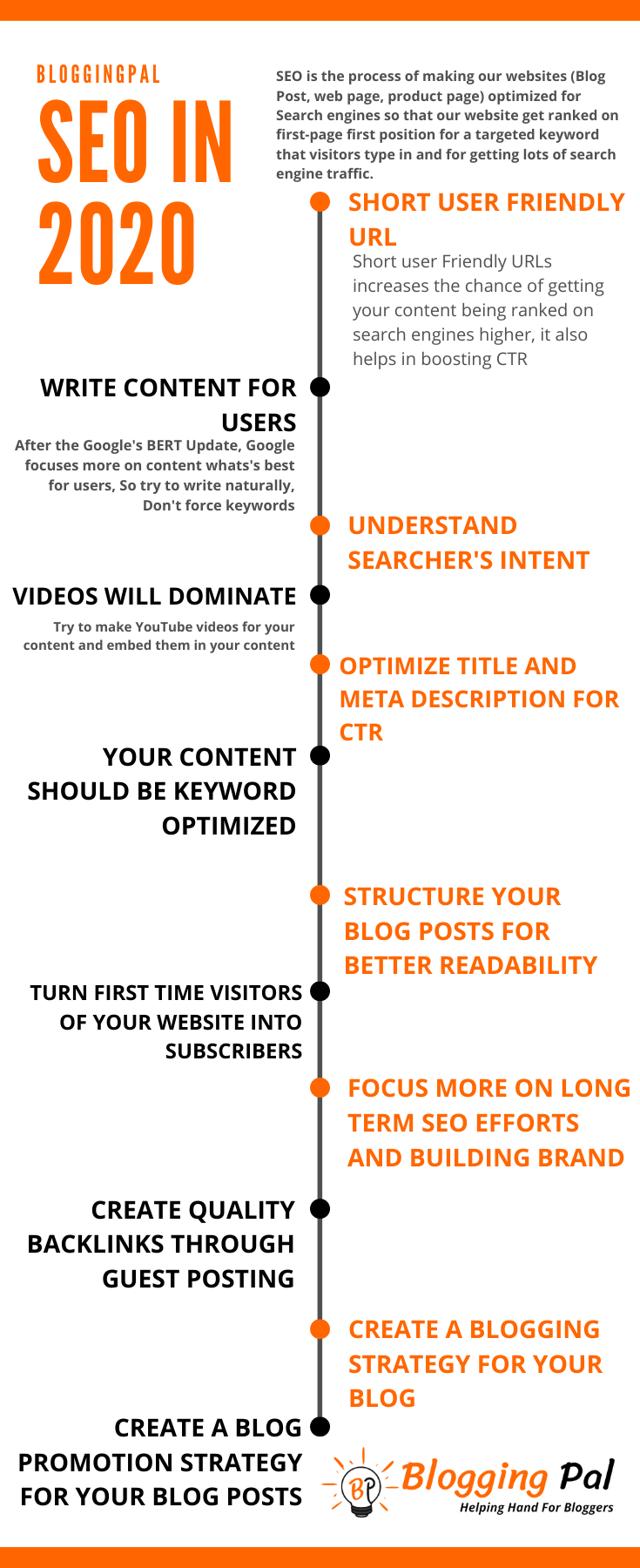
One small request
If this blog post has been of any value to you and you learned anything from It, please share it on your favorite social media sites; your valuable feedback helps us reach more awesome people like you.
Peace out ✌️

Hi Tarun
Such an incredible post. Everything related to SEO in one place.
Very well-written bro!
Thanks for sharing
Hey Amit Thanks for going through the article Brother.
And I feel really glad that you enjoyed reading this article and gained value out of it.
Cheers !!
– Aishwar Babber
Hi bro this post is just mammoth and poured with several useful terms Which was before reading this post uncleared for me.
Thank you for your nice present.
Regard!
Indranil.
Hey Indranil thanks for stopping by and reading the full content brother.
And I’m really happy that this article was helpful for you and you learned something from it.
Cheers !!
– Aishwar Babber